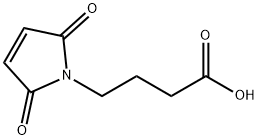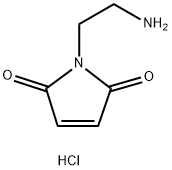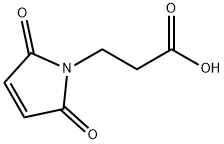N-[4-(-Carboxycyclohexylmethyl)]maleimide
- CAS NO.:64987-82-2
- Empirical Formula: C12H15NO4
- Molecular Weight: 237.25
- MDL number: MFCD03093740
- SAFETY DATA SHEET (SDS)
- Update Date: 2024-03-27 15:49:59
![N-[4-(-Carboxycyclohexylmethyl)]maleimide Structural](https://img.chemicalbook.in/CAS/GIF/64987-82-2.gif)
What is N-[4-(-Carboxycyclohexylmethyl)]maleimide?
Description
4-((2,5-Dioxo-2H-pyrrol-1(5H)-yl)methyl)cyclohexanecarboxylic acid contains a maleimide group and a terminal carboxylic acid. The terminal carboxylic acid can react with primary amine groups in the presence of activators (e.g. EDC, or HATU) to form a stable amide bond. The maleimide group will react with a thiol group to form a covalent bond, enabling the connection of biomolecule with a thiol.
Chemical properties
White Solid
The Uses of N-[4-(-Carboxycyclohexylmethyl)]maleimide
A sulfhydryl crosslinking reagent
The Uses of N-[4-(-Carboxycyclohexylmethyl)]maleimide
An amino reactive reagent.
The Uses of N-[4-(-Carboxycyclohexylmethyl)]maleimide
A sulfhydryl crosslinking reagent.
What are the applications of Application
N-[4-(-Carboxycyclohexylmethyl)]maleimide is a sulfhydryl crosslinking reagent
Definition
N-(4-Carboxycyclohexylmethyl)maleimide is an alkyl chain-based PROTAC linker that can be used in the synthesis of PROTACs. PROTACs contain two different ligands connected by a linker; one is a ligand for an E3 ubiquitin ligase and the other is for the target protein.
Properties of N-[4-(-Carboxycyclohexylmethyl)]maleimide
| Melting point: | 157-158°C |
| Boiling point: | 433.6±18.0 °C(Predicted) |
| Density | 1.329±0.06 g/cm3(Predicted) |
| storage temp. | Inert atmosphere,2-8°C |
| solubility | Chloroform, Methanol |
| form | Solid |
| pka | 4.80±0.10(Predicted) |
| color | Pale Yellow |
| InChI | InChI=1S/C12H15NO4/c14-10-5-6-11(15)13(10)7-8-1-3-9(4-2-8)12(16)17/h5-6,8-9H,1-4,7H2,(H,16,17) |
Safety information for N-[4-(-Carboxycyclohexylmethyl)]maleimide
| Signal word | Warning |
| Pictogram(s) |
 Exclamation Mark Irritant GHS07 |
| GHS Hazard Statements |
H302:Acute toxicity,oral H315:Skin corrosion/irritation H319:Serious eye damage/eye irritation H335:Specific target organ toxicity, single exposure;Respiratory tract irritation |
| Precautionary Statement Codes |
P261:Avoid breathing dust/fume/gas/mist/vapours/spray. P305+P351+P338:IF IN EYES: Rinse cautiously with water for several minutes. Remove contact lenses, if present and easy to do. Continuerinsing. |
Computed Descriptors for N-[4-(-Carboxycyclohexylmethyl)]maleimide
| InChIKey | LQILVUYCDHSGEU-UHFFFAOYSA-N |
| SMILES | C1(C(O)=O)CCC(CN2C(=O)C=CC2=O)CC1 |
New Products
4-AMINO-TETRAHYDRO-PYRAN-4-CARBOXYLIC ACID HCL 4-(Dimethylamino)tetrahydro-2H-pyran-4-carbonitrile 4-Aminotetrahydropyran-4-carbonitrile Hydrochloride (R)-3-Aminobutanenitrile Hydrochloride 3-((Dimethylamino)methyl)-5-methylhexan-2-one oxalate 1,4-Dioxa-8-azaspiro[4.5]decane 5-Bromo-2-nitropyridine Nimesulide BP Aceclofenac IP/BP/EP Diclofenac Sodium IP/BP/EP/USP Mefenamic Acid IP/BP/EP/USP Ornidazole IP Diclofenac Potassium THOMAIND PAPER PH 2.0 TO 4.5 1 BOX BUFFER CAPSULE PH 9.2 - 10 CAP SODIUM CHLORIDE 0.1N CVS ALLOXAN MONOHYDRATE 98% PLATINUM 0.5% ON 3 MM ALUMINA PELLETS (TYPE 73) LITHIUM AAS SOLUTION 2-Bromo-1-(bromomethyl)-3-chloro-5-nitrobenzene 2-Bromo-3-nitroaniline N-(3-Hydroxypropyl)-N-methylacetamide 3-Bromo-6-chloropyridazine 4-ethyl-3-nitrobenzoic acidRelated products of tetrahydrofuran








You may like
-
![N-[4-(-Carboxycyclohexylmethyl)]maleimide 95% CAS 64987-82-2](https://img.chemicalbook.in//Content/image/CP5.jpg) N-[4-(-Carboxycyclohexylmethyl)]maleimide 95% CAS 64987-82-2View Details
N-[4-(-Carboxycyclohexylmethyl)]maleimide 95% CAS 64987-82-2View Details
64987-82-2 -
 4-(N-Maleimidomethyl)cyclohexane-1-carboxylic Acid CAS 64987-82-2View Details
4-(N-Maleimidomethyl)cyclohexane-1-carboxylic Acid CAS 64987-82-2View Details
64987-82-2 -
 1823368-42-8 98%View Details
1823368-42-8 98%View Details
1823368-42-8 -
 2-(3-(tert-butyl)phenoxy)-2-methylpropanoic acid 1307449-08-6 98%View Details
2-(3-(tert-butyl)phenoxy)-2-methylpropanoic acid 1307449-08-6 98%View Details
1307449-08-6 -
 Ethyl 3-(furan-2-yl)-3-hydroxypropanoate 25408-95-1 98%View Details
Ethyl 3-(furan-2-yl)-3-hydroxypropanoate 25408-95-1 98%View Details
25408-95-1 -
 2-Chloro-5-fluoro-1-methoxy-3-methylbenzene 98%View Details
2-Chloro-5-fluoro-1-methoxy-3-methylbenzene 98%View Details
1805639-70-6 -
 1784294-80-9 98%View Details
1784294-80-9 98%View Details
1784294-80-9 -
 Lithium ClavulanateView Details
Lithium ClavulanateView Details
61177-44-4